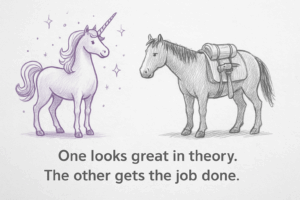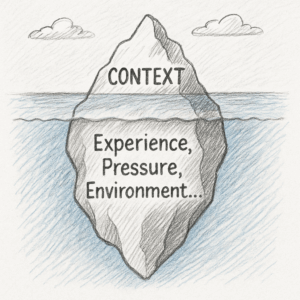Interpreting, Not Just Reporting
This article explores purple unicorns, perfect hires – and the real humans behind the profiles.
Too often, psychometric tools are used like x-rays — as if they can diagnose a candidate’s potential at a glance. But in reality, they’re more like maps. Useful, directional, sometimes surprising and revealing, but they are only as useful as the person interpreting them.
At Bishop we don’t believe in hiring by algorithm. We believe psychometrics should be used as one part of a robust, human-centred recruitment process, one that respects the individuality of each candidate, the unique context of every role, and the dynamics of the hiring team. They are part of robust risk management and particularly important at a senior level.
Preference ≠ Capability: Why Interpretation Matters
One of the most common misunderstandings about psychometric tools, especially personality profiles, is that they measure ability. In fact, most of them don’t. They measure preference.
Someone who scores as ‘introverted’, for example, isn’t incapable of confident communication. It simply means they may prefer quieter, lower-stimulation environments or draw energy from reflection rather than interaction. With time and maturity, many people develop strategies to adapt; to deliver presentations, build relationships, or lead meetings, even when those behaviours don’t sit at the centre of their natural preferences.
This is especially relevant when comparing profiles across age and experience. An 18-year-old and a 38-year-old might display very similar personality preferences, but the older candidate is likely to have developed more complex, flexible behaviours through years of experience, coaching, or necessity. The preference may not have shifted, but the way they show up certainly has. This isn’t a universal rule, many younger people have already developed strategies to manage how they show up. But typically, the profile of a younger person tends to align more closely with their everyday behaviour simply because they’ve had less time (and need) to adapt it!
In contrast, cognitive ability assessments (such as verbal, numerical or abstract reasoning) offer more of a snapshot – measuring current capability rather than preference. These skills can be improved through practice and regular use, but they can also be influenced by factors like familiarity with the test format, test anxiety or current life circumstances. They remain a useful litmus test of current cognitive capacity – but one that may shift over time.
And here’s where the real magic lies: when preference; what someone enjoys doing, aligns with ability; what they do well. That sweet spot is where performance and energy flourish (See Venn diagram: where “What I enjoy” meets “What I can do well”).
When the two don’t align, we look closer. What strategies has this person developed to manage the gap? How have they shown up in the past? How adaptable are they?
We then make an informed, human-centred decision about what the hiring risk might actually look like.

There Are No ‘Wrong’ Profiles – Only Different Kinds of Fit
Psychometrics are most useful when they’re understood as a tool to guide fit, not to pass judgement. Every style brings something valuable. And every trait has a trade-off.
Bold decision-making can sometimes come with impatience. Deep conscientiousness may show up as over-cautiousness. Flexibility might bring creativity — or inconsistency. There’s no such thing as a perfect profile. But there can be an ideal fit between the person and the role, team, or manager they’re about to work with.
The risk comes when we over-index on perceived flaws. Some hiring managers would never make a hire if they took every potential ‘development area’ as a red flag. Psychometric interpretation isn’t about seeking perfection. It’s about seeking understanding.
Beware the Purple Unicorn
In recruitment, there’s an old joke about the search for a “purple unicorn”, the mythical candidate who has every skill, every strength, no weaknesses. Oh, and a sprinkle of magic on top!
But chasing unicorns is rarely a winning strategy. The more we fixate on finding perfection, the more likely we are to overlook someone genuinely capable; someone who may not tick every box, but who brings the right mindset, adaptability and heart to the role.
At Bishop we often find ourselves saying: ‘hire for fit, train for skill’. Most technical capabilities can be learned. But curiosity, resilience, honesty and cultural alignment are much harder to build from scratch.
And let’s be honest, unicorns, for all their sparkle, look like they’d be a bit high-maintenance. And man those horns look sharp – bit of a health and safety issue if you ask me…
Instead, perhaps look for the ‘good workhorse’. Reliable. Strong. Values-led. Willing to put in the work, grow with the team, and show up consistently, even when it’s raining!
That’s not to say the purple unicorn doesn’t exist. But if you’re only willing to wait for them, you might miss a lot of brilliant, grounded humans ready to do great work.

Context Is Everything
That’s why we emphasise the importance of interpretation. We help clients take a whole-person view:
-
What might this person look like on a good day?
-
How are they likely to behave under pressure?
-
What might they need in their environment or leadership to succeed?
Often, the answers lie not just in what the profile says but in how it’s read, how it’s discussed, and how it’s applied.

From Risk Management to Onboarding Advantage
Used well, psychometrics are a powerful risk management tool. Not because they eliminate uncertainty but because they help us better anticipate it. They allow us to look ahead, not just at whether someone can do the job but at what kind of support, communication or clarity might set them up for success.
That’s why we prefer to provide coaching-focused summaries and practical insights that managers can use to improve onboarding, tailor support and encourage early wins.
From Insight to Action: Supporting Success from Day One
One of the most overlooked uses of psychometric tools is their ability to enrich the onboarding experience.
Many of the assessments we use offer optional coaching reports that highlight how someone might prefer to learn, communicate or operate under pressure. These can be hugely valuable in planning a well-paced induction, shaping early manager conversations and creating an environment where a new hire can bring their best self to work.
When used intentionally, this insight:
-
Accelerates trust and psychological safety
-
Helps avoid common early-stage misunderstandings
-
Increases engagement and confidence from both sides
-
Sends a powerful message: “we want to set you up to thrive”
It’s a small shift, but one that makes a big difference in both retention and performance.

Hiring with Optimism – Not Fear
In an age of increasing data, it’s tempting to rely on the numbers. But people aren’t algorithms. They’re nuanced, adaptable, and always evolving.
We use psychometric tools not to filter people out, but to open up better conversations. We believe recruitment, at its best, is an act of belief and that interpretation, done well, is a quiet act of care.
Because behind every good report is a better story.
And behind every candidate is a human being, capable of surprising us, if we’re willing to look beyond the page.
We’ve spent years working closely with hiring managers to support good risk management and deliver meaningful feedback – most of our hires stick. That’s how you know it works!

Let’s Talk
If you’re considering psychometric testing as part of a more robust and human-centred recruitment process, we’d love to chat.
No pressure. No hard sell. Just an open conversation about your needs and whether we can help you make hiring decisions with more clarity, care and confidence.
Visit bishopassociates.co.nz or call us for a confidential kōrero.

